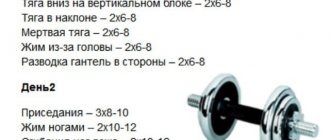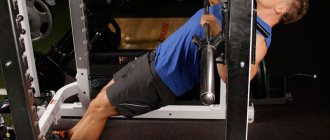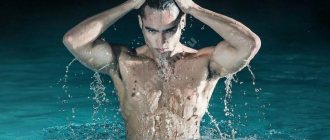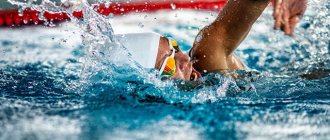Interval training is a workout that professional athletes most often resort to, but they are not contraindicated for ordinary amateurs. But the method of such training should be treated with caution by those people who are not physically developed enough, since such training will take a lot of strength and energy from you.
The essence of interval training is to alternate intense work with lighter work. Thanks to this method, you can work quite intensively without spending a lot of time on it. The opportunity to take a short break will give an even greater impetus to higher loads.
Content
- 1 Balance between different types of physical training 1.1 Planning classes
- 1.2 How will this or that series improve my performance?
- 5.1 Recommended lesson plan
Balance between different types of physical training[edit | edit code]
Lesson planning[edit | edit code]
We really like one very simple formula that helps plan training sessions and ensures optimal load distribution between warm-up, cardiovascular strengthening exercises, main and compensatory tasks.
Let's try to demonstrate the optimal, in our opinion, load distribution using the example of a three-kilometer training distance. This example can be used as a guide to action, even if your individual training distance is less or, conversely, greater than ours.
- Warm-up
- from 400 to 1000 m. The series includes most of the necessary exercises and work on mistakes. We gradually increase the intensity, increasing the amount of effort expended to a level that provides an average swimming speed.
- Strengthening part
- from 200 to 500 m. Three shorter series, designed to increase the heart rate and prepare the body for the main part of the lesson.
- The main part
is from 1200 to 2000 m. At this stage, the focus is on various aspects: swimming technique, endurance exercises, speed swimming, improving thresholds or open water swimming skills. We will go into more detail about this part of the lesson later in this chapter.
- The compensatory part
is from 100 to 400 m. This series is the most important component of any workout; it is designed to reduce the heart rate, remove accumulated lactate from the muscles, and restore ease of movement.
If you use our plan, you can organize interesting workouts. And to make this easier, our book contains Appendix B. In it, we offer six options for each part of the training session. They are approximately designed for all six types of swimmers. With their help, you can create personalized training plans that perfectly balance strength training, technique work and open water swimming skills. At the same time, you can change series, using even those that do not directly relate to your type: they will also be useful for development.
Paul Newsome: With five main series, six open water series and technique series to choose from, we estimate that you will be able to create up to 5,100 unique training plans. The figure is impressive - for starters, it should be enough for you!
How will this or that series improve my performance?[edit | edit code]
The main series can be divided into three groups.
- Speed, or sprint.
- Endurance and long-distance swimming series.
- Series to improve threshold indicators or stability of swimming speed.
Let's look at each of them, and do it in the order given above. In practice, many masters swimmers and triathletes in their training pay primary attention to speed series, somewhat less to endurance series, and devote relatively little time to series on stability of swimming speed. In Chapter 26, we'll look at how these series can be combined for maximum performance, since the goals of a long-distance swimmer are very different from those of a sprinter or triathlete.
Pulse during exercise
During the working period (under intense exercise), the pulse should not exceed 80% of the maximum heart rate (depending on age). During the recovery period, the heart rate should be about 55% of the maximum value.
The heart rate range is determined using a specific formula: (220 – athlete’s age)*(intensity in%/100).
But the calculations are made for the average person and do not take into account the characteristics of the body. Therefore, this calculation is not suitable for most athletes. Karvonen's formula is more accurate because takes into account the heart rate at rest:
(220 – age – heart rate at rest) * (intensity in %/100) + heart rate at rest.
Training series of the second type: to increase endurance[edit | edit code]
The simplest endurance training series might involve swimming for a long time at a fixed speed. This develops the ability to swim continuously for a long time. You can often find swimmers whose training time is very limited (for example, a lunch break). They jump into the water and swim and swim non-stop throughout the entire lesson. This type of training has its advantages. However, if all classes turn into continuous swimming from side to side, you miss the opportunity to work on technique and risk stopping in your development, because you are constantly swimming at virtually the same speed.
For swimmers and triathletes who compete in long-distance events (such as Ironman events), long distance swims help build confidence. Further in the article: Critical swimming speed (tests), we will tell you how to calculate the required speed in such swims, develop basic endurance and maintain good technique. Swimmers who prioritize long swims in their training make a classic mistake: they accelerate too much at the beginning and, as a result, run out of steam by the end of the race.
Breaking up your endurance training into long bursts with short rest periods will help keep you interested, motivated, and able to build up mini energy reserves during your 45-minute swims. If you want to successfully cope with long streaks and quickly recover after them, it is very important to learn how to “recharge your batteries.” In Chapter 32 we'll cover some tactics that can ensure success in long swims.
An example of a training task would be a simple series of 6 x 400 meters at 75% effort with 30 seconds of rest. For convenience, we advise you not to work at 75% effort, but to swim at maximum speed, allowing yourself to add about 8 seconds for every 100 meters.
Appendix B contains a diagram of endurance training series, the distances in which range from 2.5 to 6 kilometers. They allow you to do the workout without an auxiliary warm-up and strengthening part, since the warm-up is already included in the structure of these series. You can immediately begin swimming at a steady speed, as if you were embarking on a long, long swim in a competition. Just before you begin these series, devote 10-15 minutes to light warming up and stretching (see Additional training for swimmers on dry land).
Train your brain with fun
Develop memory, attention and thinking with the help of online simulators
START DEVELOPING
Special endurance is the body’s ability to endure long-term loads characteristic of a particular type of activity. Such endurance is a very complex and multicomponent motor quality. It is necessary to be selective in selecting the load for various exercises.
The level of development and manifestation of special endurance depends on a number of factors:
— general endurance;
— speed of resource consumption of intramuscular energy sources;
— the ability of an athlete to continue an exercise when tired due to the manifestation of volitional qualities is of particular importance;
- techniques for mastering motor action, associated with rationality, economy of technology and tactics, i.e. technical and tactical skill.
— capabilities of the neuromuscular system;
— speed capabilities (speed and flexibility of working muscles);
— coordination abilities (precision of movements);
— strength qualities and development of other motor abilities.
In turn, special endurance is divided into:
— high-speed:
— power:
— speed-power:
- coordination.
Speed endurance is characterized by the body’s ability to perform fast movements for a long time without fatigue or disruption of technique.
Strength endurance indicates the muscular ability to perform heavy exercise for a long time without visible technical impairment.
Coordination endurance presupposes the ability to perform complex exercises to coordinate motor actions for a long time and effectively.
And strength endurance, in turn, comes in two types:
— dynamic;
- static.
Dynamic strength endurance is characterized by performing heavy exercises at a relatively slow pace, but for a fairly long time.
Static strength endurance involves the ability not to change a position for a long period of time.
The choice of type of endurance depends on the goals that a person sets for himself.
Developing speed endurance has recently become my No. 1 priority. It’s just that our life is similar to the same marathon that athletes go through, only longer than the Olympic distance. And even if you don’t play sports professionally, you should still become an “athlete for life.” The only difference is that you have no other rivals except yourself.
A simple scheme for organizing training for a month[edit | edit code]
Many triathletes swim two to four times a week. If you are a masters swimmer or swim for recreational or recreational purposes, you may have more time in your schedule to practice. Either way, a good weekly or monthly program will give you confidence that you're making the most of your training time.
Ideally, in order to visibly see improvements, you need to train three or more times a week. In Perth, we often encounter swimmers who, by coming to training two to three times a week, make significant improvements, often six to nine weeks after making adjustments to their training programs.
The frequency of exercise is always more important than its duration. For example, three 30-minute workouts per week will provide more benefits than one 90-minute workout. Of course, due to your busy schedule, you won’t always be able to train, but then you need to be realistic about what results you can achieve by training once or twice a week. This way you will avoid disappointment from unfulfilled hopes.
But in fairness, it should be said that increasing the number of workouts from six to seven per week may not have much effect on your performance technique, and may even provoke apathy, demotivate you, or lead to overtraining. Nothing is more important than having the right positive attitude when you're looking forward to going to the pool. And if you swim too often, you risk losing that “magical feeling.” After working out five times a week or even more, you may find yourself dreading the next workout. Try reducing your plan by one workout per week - and you will see how the enthusiasm returns to you again. Elite swimmers and triathletes are especially susceptible to this kind of despondency, and if training is drastically cut back, many of them will find themselves much closer to success than they were previously.
“More” does not always mean “better”: effective training is the right balance between sports, work, family, friends.
Paul Newsome: As a college-trained triathlete, I thought a lot about the ideal training program that would take the optimal amount of time and include precisely dosed loads. My efforts were fruitless. I realized that the time that works for one athlete is not effective for another. In addition, various events could instantly destroy the prescribed sequence of training. Often, dramatic changes in the program can occur literally a few weeks before starting work on an already developed training program.
So I decided to take a more practical approach, which worked much better. I have developed a basic scheme that allows you to vary the load daily, weekly and monthly. This allows you to correctly combine strength training, work on technique, endurance, and threshold speed; you can repeat them many times in a row, look for combinations that suit you personally. The intensity of training is selected in accordance with your current form and implies its constant development.
Using such a scheme makes the training process simple, rational, and I highly recommend that you use it. We will present you with some of the schemes that you can rely on, taking into account your individual fitness level and time available for training.
When it comes to planning your rest, I would advise listening to your own body more, especially if you only exercise two to three times a week. In this case, you are unlikely to study so much that you need additional breaks. So if you feel fine, continue training. If you feel like you are very tired after a long stretch, swim an easy series, or even just rest.
I have always achieved my highest levels of performance with training programs that are at once simple, fun and challenging, designed to be consistent week after week. They were not like scientific superprograms designed to miraculously produce immediate results (I tried those too). Of course, you must have a goal and motivation, but if you do not follow the program, you will not achieve results. Life is full of surprises, and if your program is not flexible and does not allow you to insure yourself against unexpected breaks in the training process, then we promise: anger and irritation will soon become your companions.
Interestingly, the development of this scheme was inspired not only by our own long-term coaching practice, but also by the former head of the British Triathlon Federation, Chris Jones. Together with the amazing triathletes as part of the British World Class Triathlon curriculum, we wanted to present the material as clearly and consistently as possible. In fact, the training regimens of even elite athletes are not nearly as complex as you might imagine.
Recommended lesson plan[edit | edit code]
Scheme for organizing swimming training
The table shows the scheme that we recommend for planning your training. It is based on the number of visits to the pool per week and combines three main areas: working on technique, training itself, and developing skills in open water. You can use this pattern all year round to develop your swimming skills in open water and in the pool when the open water gets too cold. In our article on open water adaptation, we will discuss in more detail how important such training is for the development of relevant skills.
Choose a scheme and build your own training plans using Appendix B, it will add variety to your training and provide an influx of new ideas. Of course, your pool schedule may have some restrictions on possible training days, but if you try to match your schedule to our scheme as much as possible, you will be on the right track.
Adam Young: In the table. You can see the outline Paul put together in the run-up to his six months of training for the 2011 Channel Swim. Needless to say, he had to swim a lot of kilometers in preparation for the marathon, which could last 7 or 17 hours. Don't be intimidated by the distances he swam or the speed he reached. Instead, pay attention to the weekly components of his training: work on technique and open water skills, and Paul's willingness to repeat these sessions week after week in an effort to perfectly prepare for the swim.
| Day | Training program |
| Monday | Easy swim of 2-3 km, including strengthening training to prevent injury or rest |
| Tuesday | At a moderate speed, swim 6-7 km in the pool, including exercises, and continuously swim 4-6 km, consisting of 10-15 segments of 400 m at a speed of 1:24 per 100 m, rest 21 s after every 400 m (monitor performance using a metronome) |
| Wednesday | A difficult 9 km swim in a pool at a speed of 0:43-0:45 for 50 m, that is, 20 x 50 m, 10 x 100 m, 5 x 200 m, 2 x 500 m, 1 x 1000 m, 2 x 500 m, 5 x 200 m, 10 x 100 m, 20 x 50 m. The cycle time includes rest breaks, so the faster you swim, the more rest you will get. I typically completed this swim at an approximate time of 1:18 per 100m |
| Thursday | Cold (15°C/59F) open water swim 10km, approximate speed 1:24 per 100m, including 15-20 second stops to drink every 2km |
| Friday | A steady 4-5 km swim in the pool, with an emphasis on exercise and technique work. |
| Saturday | Hard swim of 8 to 12 km in cold (15 °C/59 F) open water, challenge: maintain a speed of 1:20 per 100 m |
| Sunday | The goal of the series: swim from 14 to 25 km in cold (15 ° C / 59 F) open water with an escort, in order to have a snack every 2 km. Objective: maintain a speed of 1:24 per 100 m |
Swimming and losing weight: the arguments against
Although swimming for weight loss is one of the safest and most effective types of fitness, it still has undesirable consequences and contraindications:
- after a full workout, you will feel very tired, since swimming uses all muscle groups of the body;
- After classes, you will wake up with a strong hunger, which you will really want to satisfy with a large amount of high-calorie food. This is why some nutritionists believe that swimming is not the best way to lose weight;
- main contraindications: viral infections, severe heart disease, neurological diseases, paralysis, skin infections.
From all that has been said, we can conclude that swimming undoubtedly helps fight excess weight, heals the body and improves overall well-being, but without observing dietary restrictions it will bring little benefit to your figure. If you exercise correctly and don’t indulge yourself, the results won’t take long to arrive, and you’ll understand that swimming is a great way to lose weight! And don’t forget about the opportunity to use interval swimming for weight loss, which will certainly delight you with inspiring results! Author of the article: Anna Kay










